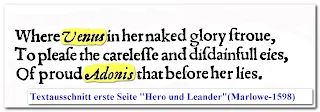"The Hero & Leander Triple"
2 independent authors (Chapman / Petowe) within the year of the first release of Marlowe's "Hero and Leander" in print (1598) felt the need and were able to complete and expand Marlowes epic poem!
Is that plausible?
Marlowe's epic poem "Hero and Leander" (H&L) for the first time appeared in print in 1598, not yet structured into 2 Sestiads [s.Fig left-]
It was expanded and printed in the same year 1598 , by George Chapman with 4 new Sestiads *1) of the same poetic style and quality, with an additional dedication [to the wife of Marlowe's Patron Thomas Walsingham Lady Audrey Shelton], with new structured headings and summaries [s.Quarto, middle figure] and in the same year 1598 it was additionally enhanced by Henry Petowe [s.Quarto, right] with a second part ("conteyning their further Fortunes"), in which the author Marlowe is praised and the metaphor "behind" Hero and Leander is interpreted .
How is it conceivable (...is it conceivable at all?) that two independent authors within the year of the the first release of Marlowe's "Hero and Leander" in print (1598) felt the need and were able to complete and expand Marlowes epic poem? Can you think of another, more plausible explanation ? What does all this have to do with Shakespeare?
An attempt at interpretation:
The original H&L by Christopher Marlowe was registered autumn 1593 (shortly after his alleged murder) but only allowed to be printed in 1598. (printed for Edward Blount , Co-Editor of the First Folio 1623). Marlowe's Poem 1593 seems to represent the spontaneous immediate parable or poetic metaphor of Leander's (alias Marlowe's) fate:
Leander asked his poetic muse Hero to light a lamp in her window, and he promises to swim the Hellespont each night to be with her. She complies. On his swim Leander is spotted by Neptune who confuses him with Ganymed and carries him to bottom of the ocean. - Discovering his mistake Neptune returns him to the shore (Marlowe's rescue) with a bracelet supposed to keep him safe from drowning.-
(No Consensus exists on the issue: if Marlowe would have finished the Poem ..Marlowe's original H&L end with the latin words "Desunt Nonnulla" , meaning , something is absent, or missing or wrong. It could well mean, that in Ovids original Story, Leander (alias Marlowe) came to death! (But not in Marlowe's version)
The original H&L by Christopher Marlowe was registered autumn 1593 (shortly after his alleged murder) but only allowed to be printed in 1598. (printed for Edward Blount , Co-Editor of the First Folio 1623). Marlowe's Poem 1593 seems to represent the spontaneous immediate parable or poetic metaphor of Leander's (alias Marlowe's) fate:
Leander asked his poetic muse Hero to light a lamp in her window, and he promises to swim the Hellespont each night to be with her. She complies. On his swim Leander is spotted by Neptune who confuses him with Ganymed and carries him to bottom of the ocean. - Discovering his mistake Neptune returns him to the shore (Marlowe's rescue) with a bracelet supposed to keep him safe from drowning.-
(No Consensus exists on the issue: if Marlowe would have finished the Poem ..Marlowe's original H&L end with the latin words "Desunt Nonnulla" , meaning , something is absent, or missing or wrong. It could well mean, that in Ovids original Story, Leander (alias Marlowe) came to death! (But not in Marlowe's version)
Marlowes original Poem (registered 1593 but printed 1598) was structured (into Sestiad 1 and 2 ) and enlarged by 4 new sestiads (3-6 1598) (with the continuation of his life story, 5 years later) , written by himself under the pseudonym George Chapman, and a second part (s.Faksimile, "conteyning their further fortunes") under the pseudonym Henry Petowe a totally unknown figure in England.
*1) In a 1600 Reprint of "Hero and Leander" (6 sestiads) , Marlowe is listed as the sole Author
Video
"The Hero and Leander Triple"





